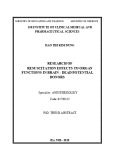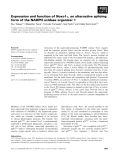
Organ functions in brain
-
The thesis is the first study which evaluates the results of formultiple organs resuscitation strategy in brain death potential donors. From the results of this study, it is recommended to optimize the hemodynamics to adequately perfusion of organs after brain death to ensure the functions of the transplanted organs later; the organs should be used in the 24 first hours frombeginning of organ resuscitation (about 12 hours after the declaring of Brain-dead diagnosis Council) because the organ functionsare is the best.
 27p
27p  angicungduoc6
angicungduoc6
 21-07-2020
21-07-2020
 14
14
 1
1
 Download
Download
-
Activation of the superoxide-producing NADPH oxidase Nox1 requires both the organizer protein Noxo1 and the activator protein Noxa1. Here we describe an alternative splicing form of Noxo1, Noxo1c, which is expressed in the testis and fetal brain.
 15p
15p  inspiron33
inspiron33
 25-03-2013
25-03-2013
 34
34
 3
3
 Download
Download
CHỦ ĐỀ BẠN MUỐN TÌM















